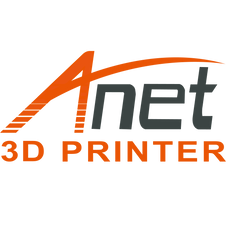Recommended Cura Settings for Anet A8 Plus
Cura is one of the most popular slicing software in FDM 3D printing. It defines a lot of important parameters and provides helpful features for successfully printing a model, for example, tree support and enable jerk control. In a word, Cura setting is quite crucial when you’re going to print with Anet A8 Plus 3D printer or any other type of FDM 3D printer. Now, let’s proceed to know some regular but necessary settings, temperature, speed, support, infill, adhesion type, and etc., on Cura to carry out a good 3D print on Anet A8 Plus 3D printer.
Hot end and bed temperature for A8 Plus
For Anet A8 Plus and many other desktop FDM 3D printers with a heat bed, printing temperatures usually include hot end (nozzle) temperature and bed temperature.
Hot end or nozzle temperature setting varies in accordance with the printing filament. When printing with PLA, it’s better to set it at recommended value in Cura or you can vary it at about 190 - 210℃. And printing ABS, the hot end temperature can be at 230 - 250℃.
Appropriate bed temperature helps better adhesion when the filament deposits onto the bed surface. Glass transit temperature when a filament transits from solid to liquid is ideal for FDM printing. For example, 60 - 75℃ is suitable for PLA printing, and 80 - 100℃ is better for ABS printing.
Print speed for Anet A8 Plus
In Cura, print speed is simply the print speed when we open the software. But when we search speed on, detailed speed settings appear.

Usually, lower speed offers better print quality. And here we recommend speed settings as below:
Print speed: 20-40mm/s
Infill speed: 30-50mm/s
Wall speed: 15-25mm/s
Outer wall speed: 20-30mm/s
Inner wall speed: 45-55mm/s
Top / bottom speed: 15-25mm/s
Support speed: 30-40mm/s
Travel speed: 100-130mm/s
Initial layer speed: 15-20mm/s
Skirt / brim speed: 15-20mm/s
Cura Infill Pattern and density for A8 Plus
Infill pattern and density are two important settings and we should decide the right value when print something for heavy weight purpose. For example, if we print a bracket to support a motor, the infill density is better to be 100%. But if it’s vase, the infill can be set to 0 for transparent-like looking into the inside of the vase.
When printing common parts have no special requirement for strength or any other elements, it’s recommended to set the infill density to 20% - 30%. Too high density wastes your filament and doesn’t make any sense.
Often, grid type infill pattern is recommended to print most 3D parts or components.
Bed plate adhesion settings for A8 Plus
Build plate adhesion includes three different types, skirt, brim and raft. They can be applied on printing different objects to enhance bed adhesion and avoid warping from happening.
Skirt is lines circle around the bottom of the printed object but don’t touch the object. It is printed first before the object itself. Skirt is usually applied on object with low warping tendency but higher bottom finish.
Brim is a thin and complete layer circles around the bottom of object and touches the object. We can consider it as a strengthened adhesion type from the skirt type. It also has tiny affection on the object itself and can be handled easily after printing. Usually, 5 – 8mm brim is the best.
Raft is an additional base under your real print. It provides the best aid to bed adhesion and it’s a good reference surface to proceed to print the object you want. If you require great precision of the object and totally avoid warping, raft can be an ideal choice.
Support in Cura Profile
Support is not recommended if there is no overhang on the object. And when support is required, we should keep in mind, the less percentage of support, the better finish of the print.
Also, when remove support, be patient enough to avoid damaging the print.
Summary
Print settings on Cura should vary according to the specific filament and object. You can follow above instructions and do some test print if you’re not so sure. And then decide the appropriate settings when printing with Anet A8 Plus 3D printer.

Leave a comment